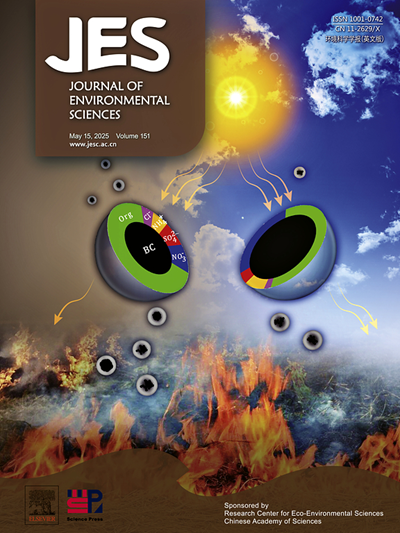Degradation of thiamphenicol by La-Fe2O3/DBD/HCP synergistic catalytic system
IF 5.9
2区 环境科学与生态学
Q1 ENVIRONMENTAL SCIENCES
引用次数: 0
Abstract
In this study, a highly efficient La-Fe2O3/dielectric barrier discharge (DBD)/honeycomb ceramic plate synergistic catalytic system was successfully constructed by using modified iron oxide (Fe2O3) catalyst coating assisted DBD plasma, and the prepared catalytic coating was fully characterized by various techniques. The results indicate that the lanthanum (La) is efficiently and uniformly doped in Fe2O3, and the modified La-Fe2O3 catalyst exhibited a better photocatalytic performance. The overuse of Thiamphenicol (TAP), as a typical chloramphenicol antibiotic, has led to its accumulation in the aquatic environment. Accordingly, TAP was selected as the target contaminant to evaluate the catalytic activity of the synergistic system. The results confirmed that the catalytic ability of the synergistic catalytic system was significantly improved, and the data showed that the degradation rate of the synergistic system reached 99.1% under the same conditions compared with 68.2% for the single DBD plasma, which effectively improved low energy efficiency limitations of the single DBD technology. Through quantitative measurements of the concentrations of dissolved ozone (O3) and hydrogen peroxide (H2O2) in the system and radical trapping experiments, combined with emission spectroscopy, the mechanism of synergistic system degradation of TAP was analyzed. The intermediates in the degradation process were characterized by high-resolution mass spectrometry, and the degradation pathway of TAP was proposed based on the analysis of the intermediates and their combination with theoretical calculations. This study presents a theoretical basis for the improvement of DBD technology and a technical guide for the removal process of antibiotics from industrial wastewater.

La-Fe2O3/DBD/HCP协同催化体系降解硫霉素
本研究利用改性氧化铁(Fe2O3)催化剂涂层辅助DBD等离子体,成功构建了高效的La-Fe2O3/介质阻挡放电(DBD)/蜂窝陶瓷板协同催化体系,并对制备的催化涂层进行了各种技术表征。结果表明,镧(La)能有效且均匀地掺杂在Fe2O3中,改性后的La-Fe2O3催化剂表现出更好的光催化性能。硫霉素作为一种典型的氯霉素类抗生素,其过量使用已导致其在水生环境中积累。因此,我们选择TAP作为目标污染物来评价协同体系的催化活性。结果证实,协同催化体系的催化能力得到了显著提高,数据显示,在相同条件下,协同催化体系的降解率达到99.1%,而单DBD等离子体的降解率为68.2%,有效改善了单DBD技术低能效的局限性。通过对体系中溶解臭氧(O3)和过氧化氢(H2O2)浓度的定量测定和自由基捕获实验,结合发射光谱分析了TAP协同体系降解的机理。利用高分辨率质谱技术对降解过程中的中间体进行表征,并在对中间体分析的基础上,结合理论计算,提出了TAP的降解途径。本研究为DBD技术的改进提供了理论依据,为工业废水中抗生素的去除工艺提供了技术指导。
本文章由计算机程序翻译,如有差异,请以英文原文为准。
求助全文
约1分钟内获得全文
求助全文
来源期刊

Journal of Environmental Sciences-china
环境科学-环境科学
CiteScore
13.70
自引率
0.00%
发文量
6354
审稿时长
2.6 months
期刊介绍:
The Journal of Environmental Sciences is an international journal started in 1989. The journal is devoted to publish original, peer-reviewed research papers on main aspects of environmental sciences, such as environmental chemistry, environmental biology, ecology, geosciences and environmental physics. Appropriate subjects include basic and applied research on atmospheric, terrestrial and aquatic environments, pollution control and abatement technology, conservation of natural resources, environmental health and toxicology. Announcements of international environmental science meetings and other recent information are also included.
文献相关原料
公司名称
产品信息
阿拉丁
ethylene glycol ((CH2OH)2)
阿拉丁
lanthanum nitrate (La(NO3)3)
阿拉丁
iron III nitrate (Fe(NO3)3·9H2O)
阿拉丁
Thiamphenicol (TAP, C12H15Cl2NO5S)
 求助内容:
求助内容: 应助结果提醒方式:
应助结果提醒方式:


